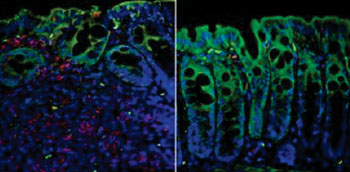Discovery of Pain Receptor on T-cells Could Help Treat Autoimmune Disorders
By LabMedica International staff writers
Posted on 20 Oct 2014
Researchers have discovered that T-cells are activated by a pain receptor. The new findings revealed that the receptor helps control intestinal inflammation in mice and that its activity can be adjusted, providing a potential new target for treating certain autoimmune disorders, such as Crohn’s disease and possibly multiple sclerosis.Posted on 20 Oct 2014
The study’s findings were published online October 5, 2014, in the journal Nature Immunology. “We have a new way to regulate T-cell activation and potentially better control immune-mediated diseases,” said senior author Eyal Raz, MD, professor of medicine at the University of California, San Diego School of Medicine (USA).

Inflammatory response and damage to the intenstinal wall (left) could be prevented by injecting TRPV1-deficient T-cells (right). Photo courtesy of Nature Immunulogy, Bertin et al.).
The receptor, called a TRPV1 channel, has a well-recognized role on nerve cells that help regulate body temperature and alert the brain to heat and pain. It is also called the capsaicin receptor because of its role in creating the sensation of heat from chili peppers.
The study is the first to show that these channels are also present on T-cells, where they are involved in gating the influx of calcium ions into cells—a process that is required for T-cell activation. “Our study breaks current dogma in which certain ion channels called CRAC are the only players involved in calcium entry required for T-cell function,” said lead author Samuel Bertin, a postdoctoral researcher in the Raz laboratory. “Understanding the physical structures that enable calcium influx is critical to understanding the body’s immune response.”
T-cells are targeted by the HIV virus and their destruction is why individuals with AIDS have compromised immune function. Specific vaccines also harness T-cells by exploiting their ability to recognize antigens and trigger the production of antibodies, conferring disease resistance. Allergies, in contrast, may occur when T-cells recognize harmless substances as pathogenic.
TRPV1 channels appear to offer a way to manipulate T-cell response as needed for health. Specifically, in in-vitro experiments, researchers showed that T-cell inflammatory response could be reduced by knocking down the gene that encodes for the protein that comprises the TRPV1 channel. Overexpression of this gene was shown to lead to a surge in T-cell activation, which in human health may contribute to autoimmune diseases. T-cells also responded to pharmaceutical agents that block or activate the TRPV1 channel.
In research using mice models, researchers were able to reduce colitis with a TRPV1-blocker, initially developed as a new painkiller. One of the exciting discoveries is that colitis in mice could be treated with much lower doses than what is needed to dull pain. “This suggests we could potentially treat some autoimmune diseases with doses that would not affect people's protective pain response,” Dr. Raz said.
Related Links:
University of California, San Diego School of Medicine













